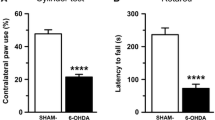Summary
Rats were treated continuously for 12 months with therapeutically equivalent doses of haloperidol (1.4–1.6 mg/kg/day), sulpiride (102–109 mg/kg/day) or clozapine (24–27 mg/kg/day) and examined for alterations in brain glutamic acid decarboxylase (GAD) and3H-flunitrazepam binding.
Administration of haloperidol, but not sulpiride or clozapine, for 6 or 12 months increased striatal GAD activity. None of the drug treatments altered nigral GAD activity when examined after 1, 3, 6, 9 or 12 months administration.
The number of specific3H-flunitrazepam binding sites (Bmax) in striatal membrane preparations were not altered by 12 months administration of haloperidol, sulpiride or clozapine. Surprisingly, Bmax for3H-flunitrazepam binding to cerebellar membrane preparations was decreased-by 12 months administration of all drug treatments. The dissociation constant (Kd) for3H-flunitrazepam binding in striatal and cerebellar preparations was not altered. The ability of GABA (0.25–100 μM) alone, and in conjunction with sodium chloride (200 mM), to stimulate specific3H-flunitrazepam binding in striatal and cerebellar preparations was unaltered by haloperidol, sulpiride or clozapine administration for 12 months. The selective effect of haloperidol, but not sulpiride or clozapine, treatment on striatal GAD activity parallels the ability of haloperidol, but not sulpiride or clozapine, to induce striatal dopamine receptor supersensitivity in the same animals. The actions of haloperidol may reflect its greater ability to induce tardive dyskinesia compared to sulpiride or clozapine.
Similar content being viewed by others
References
Alberts JL, Francois F, Josserand F (1985) Étude des effets secondaires rapportes a l'occasion de traitments par dogmatil. Sem Hosp 61: 1351–1357
Bird ED, Spokes EG, Barnes J, Mackay AVP, Iversen LL, Shephard M (1977) Increased brain dopamine and reduced glutamic acid decarboxylase and choline acetyltransferase activity in schizophrenia and related psychosis. Lancet ii: 1157–1159
Crow TJ, Owen F, Cross AJ, Lofthouse R, Longden A (1978) Brain biochemistry in schizophrenia (letter). Lancet i: 36–37
Crow TJ, Cross AJ, Johnstone EC, Owen F, Owens DGC, Waddington JL (1982) Abnormal involuntary movements in schizophrenia: Are they related to the disease process or its treatment? Are they associated with changes in dopamine receptors? J Clin Psychopharmacol 2: 336–340
Gerlach J, Koppelhuis P, Helweg E, Monrad A (1974) Clozapine and haloperidol in a single-blind cross-over trial: therapeutic and biochemical aspects in the treatment of schizophrenia. Acta Psychiat Scand 50: 410–424
Gerlach J, Rye T, Kristofansen P (1978) Effect of baclofen on tardive dyskinesia. Psychopharmacology 56: 145–151
Gunne L-M, Haggstrom JE (1983) Reductions of nigral glutamic acid decarboxylase in rats with neuroleptic-induced oral dyskinesia. Psychopharmacology 81: 191–194
Gunne L-M, Haggstrom J-E, Sjoquist B (1984) Association with persistent neuroleptic-induced dyskinesia of regional changes in brain GABA synthesis. Nature 309: 347–349
Horton RW, Prestwich JA, Meldrum BS (1982) γ-Aminobutyric acid and benzodiazepine binding sites in audiogenic seizure susceptible mice. J Neurochem 39: 864–870
Klawans HL (1973) The pharmacology of extrapyramidal movement disorders. In: Cohen MM (ed) Monographs on neural science. Karger, Basel, pp 1–137
Korsgaard S (1976) Baclofen (Lioresal) in the treatment of neurolepticinduced tardive dyskinesia. Acta Psychiat Scand 54: 17–24
Lloyd KG, Hornykiewicz O (1977) Effect of chronic neuroleptic or L-dopa administration on GABA levels in the rat substantia nigra. Life Sci 21: 1489–1495
Lloyd KG, Shibuya M, Davidson L, Hornykiewicz O (1977) Chronic neuroleptic therapy: tolerance and GABA systems. In: Costa E, Gessa GL (eds) Advances in biochemical psychopharmacology, vol 16. Raven Press, New York, pp 409–415
Lowry OH, Rosebrough NJ, Farr AL, Randall RJ (1951) Protein measurement with the Folin phenol reagent. J Biol Chem 193: 265–275
Marco E, Mao CC, Revuelta A, Peralta E, Costa E (1978) Turnover rates of γ-aminobutyric acid in substantia nigra, n. caudatus, globus pallidus and n. acccumbens of rats injected with cataleptogenic and non-cataleptogenic antipsychotics. Neuropharmacology 17: 589–596
Matz R, Rick W, Oh D, Thompson H, Gershon S (1974) Clozapine—a potential-antipsychochotic agent without extrapyramidal manifestations. Curr Ther Res 16: 687–695
O'Flanagan PM (1975) Clonazepam in the treatment of drug-induced dyskinesia. Br Med J 1: 269
Perry EK, Blessed G, Perry RH, Tomlin BE (1978) Brain biochemistry in schizophrenia. (Letter) Lancet i: 35–36
Roberts E, Simonsen DG (1963) Some properties of L-glutamic acid decarboxylase in mouse brain. Biochem Pharmacol 12: 113–134
Rupniak NMJ, Kilpatrick G, Hall MD, Jenner P, Marsden CD (1984) Differential alterations in striatal dopamine receptor sensitivity induced by repeated administration of clinically equivalent doses of haloperidol, sulpiride or clozapine in rats. Psychopharmacology 84: 512–519
Rupniak NMJ, Mann S, Hall MD, Fleminger S, Kilpatrick G, Jenner P, Marsden CD (1984) Differential effects of continuous administration for 1 year of haloperidol or sulpiride on striatal dopamine function in the rat. Psychopharmacology 84: 503–511
Rupniak NMJ, Hall MD, Mann S, Fleminger S, Kilpatrick G, Jenner P, Marsden CD (1985 a) Chronic treatment with clozapine, unlike haloperidol, does not induce changes in striatal D-2 receptor function in the rat. Biochem Pharmacol 34: 2755–2763
Rupniak NMJ, Jenner P, Marsden CD (1985 b) Pharmacological characterisation of spontaneous or drug-associated purposeless chewing movements in rats. Psychopharmacology 85: 71–79
Tamminga CA, Crayton TW, Chase TN (1979) Improvement in tardive dyskinesia after muscimol therapy. Arch Gen Psychiat 36: 595–598
Titeler M, Seeman P (1980) Radioreceptor labelling of pre- and post-synaptic dopamine receptors. In: Cattabeni F, Racagni G, Spano PF, Costa E (eds) Long-term effects of neuroleptics. Raven Press, New York, pp 159–165 (Adv Biochem Psychopharmacol, vol 24)
Author information
Authors and Affiliations
Rights and permissions
About this article
Cite this article
Rupniak, N.M.J., Prestwich, S.A., Horton, R.W. et al. Alterations in cerebral glutamic acid decarboxylase and3H-flunitrazepam binding during continuous treatment of rats for up to 1 year with haloperidol, sulpiride or clozapine. J. Neural Transmission 68, 113–125 (1987). https://doi.org/10.1007/BF01244643
Received:
Revised:
Issue Date:
DOI: https://doi.org/10.1007/BF01244643




